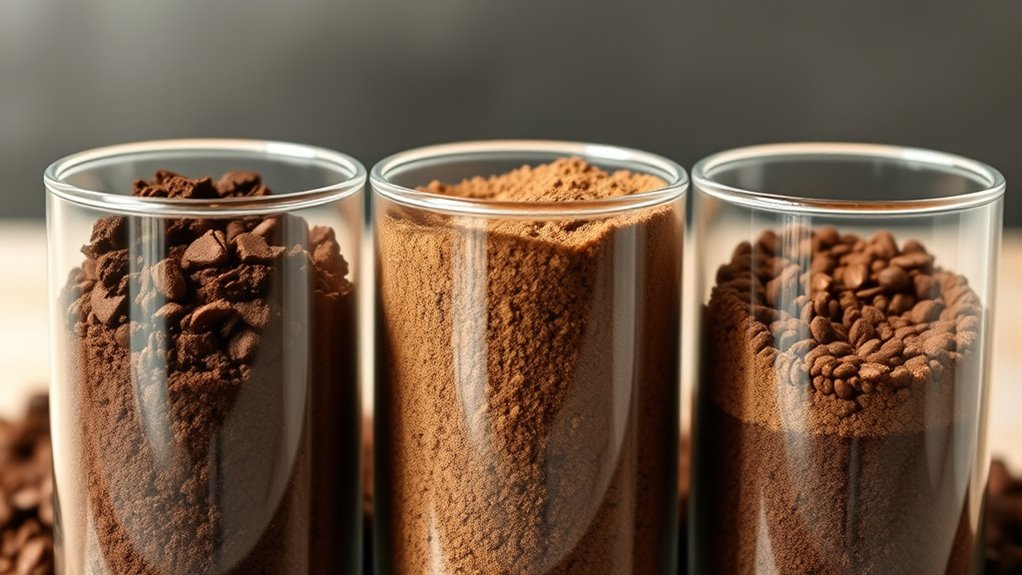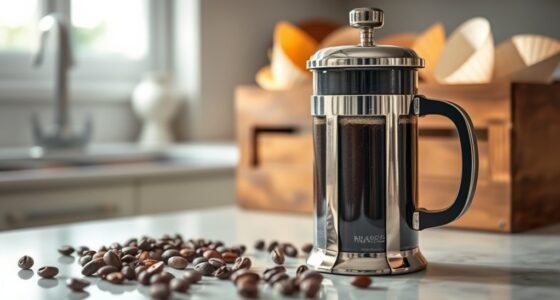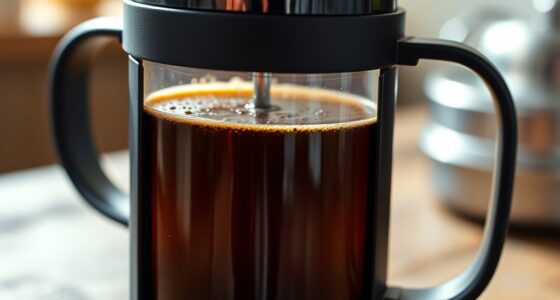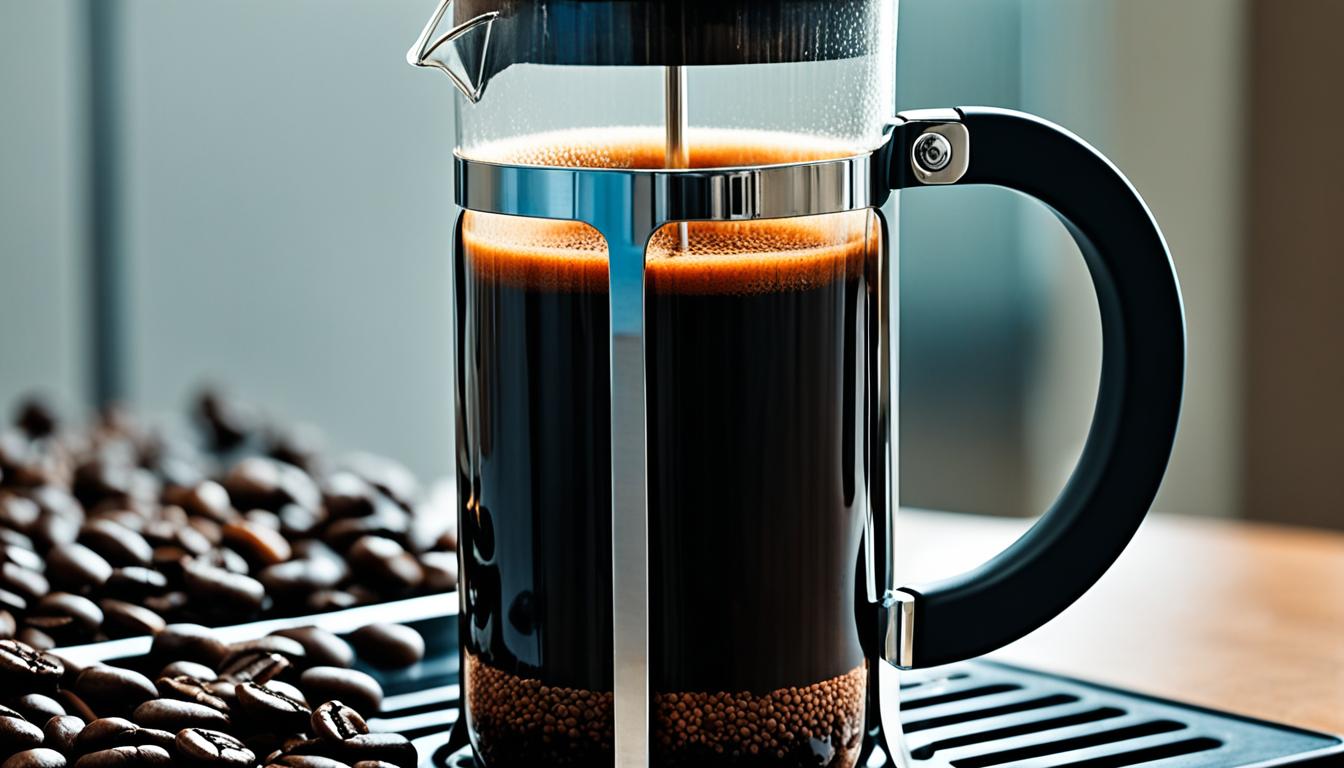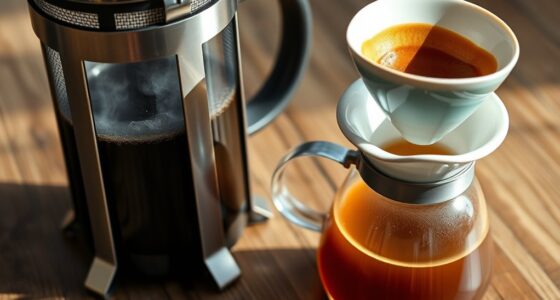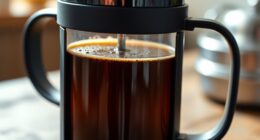For the best French press brew, choose a coarse grind to guarantee slow water flow and proper extraction. If you prefer a richer flavor with quicker steeping, try a medium-coarse grind, which increases surface area slightly. An in-between grind offers flexibility for fine-tuning your brew to taste and timing. Adjusting your grind size based on these options can improve your coffee’s flavor and consistency—keep going to discover more tips for perfecting your French press.
Key Takeaways
- Coarse grind is ideal for French press, allowing slow extraction and preventing over-extraction or clogging.
- Medium-coarse offers a balance, increasing surface area for richer flavor without risking over-extraction.
- In-between grinds provide flexibility to adjust brew time and flavor profile based on personal preference.
- Finer grounds can lead to over-extraction, bitterness, and grit, so typically avoid them for French press.
- Coarser grinds generally produce a cleaner, more controlled brew, making them the recommended starting point.

Choosing the right grind size is vital for making a great French press coffee. The grind size directly impacts how the coffee extracts, influencing both flavor and overall brew quality. When you’re dialing in your method, pay close attention to your brew time and water temperature, as these factors work hand-in-hand with grind size to produce the perfect cup. A coarse grind is typically recommended for French press brewing because it allows water to pass through the coffee grounds more slowly, giving you control over the extraction process. If your grind is too fine, the water will flow too quickly or get stuck, leading to over-extraction or a gritty texture. Conversely, a grind that’s too coarse may result in under-extraction, making your coffee taste weak and flat. Finding that balanced, coarse grind allows you to optimize your brew time—usually around four minutes—and water temperature, ideally just off the boil at about 200°F (93°C). This combination ensures the grounds are adequately extracted without becoming bitter or overly weak.
Additionally, the particle size affects the surface area of the grounds, which directly influences extraction speed and flavor profile. When you use a medium-coarse grind, you’re slightly adjusting the extraction process. This grind size offers a bit more surface area than a coarse grind, which can speed up the brew slightly. If you prefer a slightly richer or more robust flavor, experimenting with this grind size might be worthwhile. Keep in mind, though, that the brew time should be monitored carefully. Because medium-coarse grounds extract more quickly, you might want to slightly reduce your brew time to prevent over-extraction. Water temperature remains vital here—staying close to that ideal 200°F helps prevent under- or over-extraction, especially when using a finer grind. Remember, the goal is to keep the grounds evenly saturated during steeping, so consistent water temperature is key.
In-between grinds, as the name suggests, fall somewhere between coarse and medium-coarse. This grind gives you a bit more flexibility, especially if your coffee tastes a little off with the extremes. It’s a good choice if you’re fine-tuning your brew time or water temperature. For instance, if your coffee is too bitter, try a slightly coarser grind and extend your brew time. If it’s too weak, opt for a finer grind and shorten the steeping period. The water temperature should stay stable, as fluctuations can cause uneven extraction. Ultimately, the right grind size depends on balancing your brew time and water temperature to match your taste preferences. Adjusting one or both based on your grind will help you craft a consistently excellent French press coffee.
Frequently Asked Questions
How Does Grind Size Affect Brewing Time?
Your grind size directly affects brew time consistency; finer grinds extract faster, shortening your brew, while coarser grinds take longer. If your grind size isn’t accurate, your brew time can become unpredictable, leading to over- or under-extracted coffee. To achieve a balanced flavor, keep your grind consistent and match it to your French press, ensuring your brew time remains steady and your coffee tastes just right.
Can I Use a Blade Grinder for French Press?
You can use a blade grinder for French press, but be aware it may affect grind size consistency, leading to uneven extraction. Blade grinders are less precise and can produce inconsistent coarse grinds, which might require extra grinder maintenance to keep performance ideal. For the best results, consider upgrading to a burr grinder, ensuring consistent grind size and smoother brewing, making your French press coffee richer and more balanced.
What’s the Best Grind Size for Cold Brew?
For cold brew, you should use a coarse grind size to guarantee proper extraction. This grind offers consistent size, which is essential for even brewing, especially since cold brew involves a longer steeping time at lower temperatures. If your grind is too fine, it can lead to over-extraction and a bitter taste. A coarse grind helps maintain grind consistency and prevents over-extraction, resulting in a smoother, more balanced cold brew.
How Often Should I Adjust My Grind Size?
You should adjust your grind size whenever your coffee’s flavor or extraction isn’t to your liking. Regularly check your grind consistency to make certain of uniform particles, which helps maintain quality. If you notice under-extraction or over-extraction, recalibrate your grinder to achieve the ideal coarse or medium-coarse grind for your French press. Making small, gradual adjustments ensures better control over your brew and consistent results every time.
Does Grind Size Impact the Coffee’s Flavor Profile?
Think of grind size as the key to unleashing your coffee’s true character. A coarser grind allows for slower flavor extraction, preserving rich aroma development and subtle nuances. Medium-coarse offers a balanced taste, while finer grinds can lead to over-extraction, dulling flavors. Yes, your grind size directly impacts the flavor profile, shaping the aroma and depth of each cup. Adjusting it is essential for a perfect, personalized brew.
Conclusion
Choosing the right grind size for your French press can make all the difference—coarse, medium-coarse, or in-between. Did you know that a proper grind can improve your coffee’s flavor by up to 30%? So, next time you brew, remember that a slightly coarser grind often yields the richest, most balanced cup. Experiment a bit, and you’ll find what works best for you. Happy brewing!
